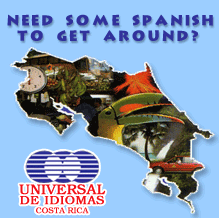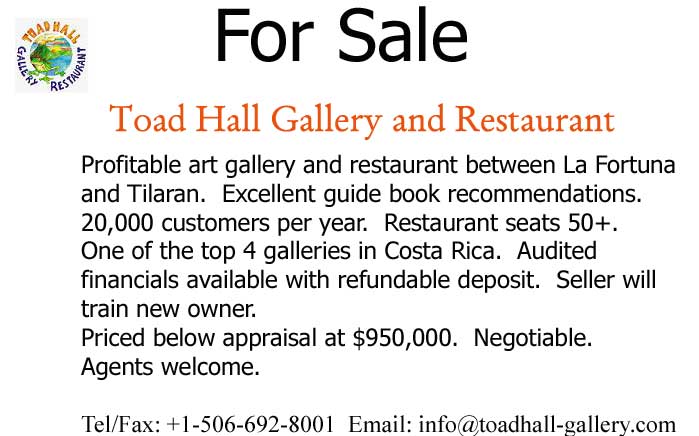Your daily
English-language
news source
Monday through Friday

| |
Your daily |
 |
|
|
|
|
|
|
|
|
|
|
|
|
|
|||||||||||||
|
|
 |
| A.M. Costa Rica Second newspage |
 |
||||||||
| Home |
Tourism |
Calendar |
Classifieds |
Entertainment |
Real
estate |
Rentals |
Sports |
About us |
|
| San José, Costa Rica, Monday, June 18, 2007, Vol. 7, No. 119 | |||||||||
 |
| Costa Rica Expertise Ltd http://crexpertise.com E-mail info@crexpertise.com Tel:506-256-8585 Fax:506-256-7575 |
 |
 Click HERE
for great
hotel discounts
|
|
to mark U.S. independence By the A.M. Costa Rica staff
The American Legion will hold an Independence Day picnic in Alajuela Saturday, July 7. A spokesman for American Legion Post 16 said that there will be the traditional hamburgers, hot dogs and fried chicken. Soda and beer will be served. The picnic will be from 9 a.m. to 1:30 p.m. at the La Cueva in Alajuela, the organization said. "We have space for 300 people," said the post spokesman. Tickets will be on sale at Hospital Clinica Santa María, Avenida 8 at Calle 14 at the veterans office, the spokesman said. The admission is 4,000 colons for adults and 2,000 colons per child. The Legion is trying to pick up the slack from the American Colony Committee, which unexpectedly canceled the free traditional July 4 celebration this year. The committee said it will put on a picnic in 2008, but not everyone is convinced. There are other groups that have considered filling the gap, too, but the Legion, the SFC Raymond Edison Jones Jr. post, is the first to announce firm plans. San Antonio de Belén hit again with flood waters By the A.M. Costa Rica staff
San Antonio de Belén suffered more flooding Saturday in the vicinity of the Río Quebrada Seca there. This is the same area that experienced five-feet of flood water Wednesday. About 1,000 persons are affected. The bad news is that weather officials say that another tropical storm front is coming and might be here in less than 48 hours. Other parts of the country also suffered flooding. Barrio San José in Alajuela was one. Sunday gave those battling mud and loss of property a break. There was hardly any rain reported. A few drops fell at Juan Santamaría airport and in Heredia, but San José was dry, as were Limón and Liberia. The Instituto Meteorológico Nacional predicts isolated thunderstorms for this afternoon all over the country. Another hot day with temperatures in the low 30s (high 80s F.) is predicted. Interbus runs off road and lands on house By the A.M. Costa Rica staff
An Interbus vehicle transporting North American passengers lost its brakes and ended up atop a house in San Ramón over the weekend. No one was injured but the almost new home was damaged heavily. The vehicle struck a wall before coming to rest amid the ruins of the home, which is at a level lower than the highway. The four tourists emerged unhurt, said a report from the scene. New hydro plant officially put into service by Arias By the A.M. Costa Rica staff
The Central Hidroeléctrica La Joya was inaugurated Friday. This is a unique operation because a Spanish firm will run it for 20 years under a grant of a concession. President Óscar Arias Sánchez did the honors. The plant generates about 50 megawatts, which is about 3 percent of the national requirement. La Joya is on the Río Reventazón some 60 kms (about 38 miles) from San José. The plant gets its water from the Cachí hydro plant through an 8 km. tunnel, some 5 miles. The plant went into operation a year ago under the control of the Unión Fenosa, the Spanish firm Guard kills robbery suspect, then police arrest him By the A.M. Costa Rica staff
A man who did not carry identification papers died about 6:30 a.m. Sunday when a guard shot him twice in the chest. The guard said that he and others were trying to burglarize a restaurant in Barrio California. The man who was shot was believed to be on the roof. When police found that the dead man was unarmed, they arrested the guard, who is expected to say he was in fear of his life. The area is immediately east of Downtown San José where Avenida 2 and Avenida Central come together.
|
 |
 |
|
on our real estate page HERE! |
| A.M. Costa Rica third newspage |
 |
||||||||
| Home |
Tourism |
Calendar |
Classifieds |
Entertainment |
Real
estate |
Rentals |
Sports |
About us |
|
| San José, Costa Rica, Monday, June 18, 2007, Vol. 7, No. 119 | |||||||||
 |
| Brothers
ran an integrated operation, they said Villalobos judges wrote a comprehensive, supported decision |
|
|
By the A.M. Costa Rica staff
An analysis of the 1,000-page final decision in the Oswaldo Villalobo criminal case shows that the judges took their job seriously and studied the testimony and written evidence in detail. The decision also validates the strategy of anti-drug prosecutor Walter Espinoza, who brought in as witnesses many older Costa Rican women who had lost $10,000, $15,000 or $20,000 to the Brothers Villalobos high interest scheme. The core of the decision, in which Oswaldo Villalobos Camacho got 18 years for aggravated fraud, was finding that his Ofinter S.A. money exchange house and the high-interest operation identified with the brother, Luis Enrique Villalobos Camacho, were an integrated unit. To an equal extent, the decision casts a guilty shadow on Luis Enrique. Throughout the decision, the judges write about the so-called sistema alternativo de emergencia, a document found in the home of Oswaldo Villalobos. In the document the brothers planned what they would do if they had to go out of business quickly and leave creditors hanging. In one part, they say that many investors will not go to authorities because they were hiding money from the tax officials in the United States. The judges, Isabel Porras Porras, Manuel Rojas Salas and Juan Carlos Pérez Murillo, seemed unhappy that the Villalobos business cards identified his operation as a "branch of the all-powerful God and sons." That fact was mentioned twice in the decision. During the trial, the judges kept poker faces. But the decision shows they were paying close attention. The had bad opinions of some witnesses. Of Luis Guillermo Angulo Jiménez, the manager of the Mall San Pedro office of Ofinter, S.A., the judges said he only came to the courtroom to lie. He said he did not know business essentials of the office and tried to cover up the true activities, the judges said. Also coming in for criticism was Robert Cox, whom they described as bragging and not very serious. Cox is a leader of the group of investors who believe Luis Enrique Villalobos, a fugitive, will return to pay them the money he owes them. Cox is a former business partner of Villalobos. Cox told the court that he thought Luis Enrique Villalobos made money in great quantities by investing in undefined European funds. However, he was unable to provide specifics. The judges said he was not a credible witness and that it was totally irrational for him to have lost what he said was $2 million in the Villalobos high interest scheme and not take some form of legal action. In finding that the money exchange house and the Luis Enrique borrowing operation were an integrated enterprise, the judges relied on much publc testimony. But they also dug into boxes of evidence to determine, according to the decision: |
• when opening a bank account in
Spain, Oswaldo Villalobos identified
his brother, Luis Enrique, in writing as the principal shareholder of
Ofinter. • Luis Enrique Villalobos and employee David Mathieson had the same telephone number as the Ofinter S.A. money exchange house on their business cards because the businesses shared a central telephone system. • When the money exchange house opened a branch at Mall San Pedro, it was Luis Enrique Villalobos who contacted the relevant financial authorities to notify them of the move. • In a 1997 letter signed by Luis Enrique Villalobos, the brothers announced a move to Mall San Pedro in which Villalobos said that they would continue to offer services such as money exchange. The money exchange house and the Luis Enrique Villalobos operation were adjacent on the second floor of the mall. Although the two brothers claimed the businesses were separate, the court said that in reality they were two faces or two facades of the same phenomenon which was very useful for the ends of those who were behind both. In direct testimony the court heard that the firm of Oswaldo Villalobos handled and invested the money that was brought in by his brother's operation. The judges also explained why Oswado Villalobos was not convicted of money laundering. The judges said that under Costa Rican law an individual has to have knowledge of the illegal source of funds to be convicted. Although testimony and paperwork showed that Canadian drug smugglers had deposited funds earned through crime, the judges said that the prosecutor had not proved Oswaldo Villalobos knew that. A key piece of evidence had not been translated into Spanish and was not considered, according to the decision. Throughout the 1,000-page document the judges have obvious sympathy for those whose lives were ruined by the loss of their funds. They cited witnesses by name who had lost money. Most were older, and some were widows. In one case a women whom the judges described as honest, humble, sincere and simple handed over $16,000 just two weeks before the brothers closed up their operation in 2002. Although the Oswaldo Villalobos trial was hard to follow and much evidence never was presented in public, the written decision is comprehensive and compelling. This will be the decision that lawyers for Oswaldo Villalobos will try to appeal to a higher court. Meanwhile, the 62-year-old Oswaldo is jailed. Prosecutors say the operation took in about $400 million, although official figures are incomplete. Counting the interest at 3 percent a month, the Villalobos brothers had liabilities of about $1 billion when they closed up Oct. 14, 2002. This is the third and last article based on the final decision in the Oswaldo Villalobos case. |
|
Hey, youze guys: more
discussion of the forms of pronouns
|
|||
| Today,
with your kind indulgence, I would like to diverge a bit from my usual
topic of Costa Rican colloquialisms and take up a grammatical question
that appears to plague several of my readers as well as many others who
are new to the study of the Spanish language. In last week’s column, entitled Cuando todo el mundo se equivoca, todo el mundo tiene razón, among other things I tried to address the concerns of some readers over the fact that the second person pronoun of formal address usted takes the same verb endings as the third person pronouns el and ella. There are those of you out there who, quite understandably, feel that this should make usted a third-person pronoun rather than second. On the face of it, this may seem like a fairly dry and boring topic, but as I have delved further into the question, I’ve found it to be really quite fascinating. Once again I have prevailed upon my good friend, Dr. Frank Banta, professor emeritus of linguistics from Indiana University, for guidance, and he has very kindly provided me with a brief tutorial: Let’s begin with honorifics. Professor Banta tells me that these are special words, which are used to express respect. Japanese is often cited as a primary example, but such polite terms are used widely in most other languages as well. In English, for example, we may use “the gentleman” or “the lady.” What brand of gin would the gentleman prefer in his Martini? Does the lady wish a taxi? “Gentleman” and “lady” are of course nouns, which ordinarily are third person (the person or thing spoken about), but when used as such honorifics they function as second-person pronouns (the person spoken to). These locutions have led to the common use of third-person pronouns (he, she, they) in second-person function. The Roman Empire was divided into East and West in 395, with each part having its own emperor. In theory it was still a single empire, so when a citizen was addressing one emperor, theoretically they were both being addressed. It became proper, therefore, that when speaking to one or the other emperor the plural pronoun should be used. Over time this produced a fundamental change in the Latin language — and eventually all the other Romance languages that it spawned — and the plural pronoun came to be used in addressing any high-ranking official as well as, in due course, anyone to be shown respect. Ultimately the custom spread to adjacent Germanic languages, such as English, German, and Swedish. Exact usage in the various languages differs with time, social status, dialect, and sex. The pronouns used originally were third-person, plural, or both. The thing they have in common is that they are NOT the original second-person singular but have come to function as second person. In languages requiring agreement of subject and verb |
(Spanish yo como, tu comes, usted come, él/ella come) they continue to take a third-person and/or plural ending. But everyone understands them to be a form of address (person spoken to) and therefore, by definition, function as second-person pronouns. English provides a simple example. Older English had the second-person pronouns thou (singular) and you (plural). You came to be used as the polite form when addressing one person, while also continuing to be used as the plural. Gradually thou has disappeared, surviving only in prayer and poetry, while you has lost its connotation of respect in the singular, thus leaving the language a bit poorer. In some dialects you is felt only to be singular, leading to such ‘pluralized’ forms as y’all, you’uns, or youze guys. In French development was at first similar. Vous was originally only plural, then came to be used to address a single person for whom the speaker felt respect, but, of course, retained its plural ending even though the singular meaning was clear. French, however, has not lost its original singular form, tu. Development in Spanish, though different, produced a familiar result. Here the polite, or formal, form of address was Vuestra Merced, “Your Grace” (put in modern Spanish form), plural being Vuestras Mercedes “your Grace(s). Gradually this phrase was reduced to a single pronoun Usarced(es) until finally today it has become Usted(es), which continues to take third-person verb endings while functioning exclusively as second person. In modern Spain tu and vosotros are used as familiar forms, but tu is not commonly used among native Costa Ricans (though they do, of course, understand it) and vosotros has fallen into fairly general disuse throughout most of Latin America. The originally plural vos (with its own set of verb endings) continues in use as the familiar — really intimate — second-person singular in Costa Rica and Argentina. There are, of course, many other interesting dialect developments. But that’s a story for another day. |
||
 |
| You need to see Costa Rican tourism information HERE! |
| A.M. Costa Rica fourth news page |
|||||||||
| Home |
Tourism |
Calendar |
Classifieds |
Entertainment |
Real
estate |
Rentals |
Sports |
About us |
|
| San José, Costa Rica, Monday, June 18, 2007, Vol. 7, No. 119 | |||||||||
| Andean trade group will begin negotiations with the European Union |
|
|
By the A.M. Costa Rica wire services
Several South American presidents meeting in Tarija, Bolivia, have agreed to start trade talks with the European Union. However, Thursday's summit of the Community of Andean Nations exposed differences among the leaders of the four-nation community. The Peruvian and Colombian presidents, Alan Garcia and Alvaro Uribe, favor free trade while the left-leaning Ecuadorian and Bolivian leaders, Rafael Correa and Evo Morales, prefer state controls. Chile's president, Michelle Bachelet, who also supports free |
trade,
attended the summit. Chile is returning to the community as an
associate member after leaving the group 30 years ago. Venezuelan President Hugo Chávez pulled his country out of the group last year to protest a free-trade agreement signed by Peru and Colombia with the United States. Trade last year between the EU and Andean bloc totaled more than $15 billion. The Community of Andean Nations also includes associate members Argentina, Brazil, Paraguay and Uruguay, as well as observer countries México and Panamá. |
| Cuban official calls Michael Moore's movie good publicity for island |
|
|
By the A.M. Costa Rica wire services
Cuba's health ministry says U.S. filmmaker Michael Moore's new movie, "Sicko," will be good publicity for the Cuban health care system. Health Minister José Ramón Balaguer told reporters in Havana Friday that Moore's movie, screened last month at the Cannes film festival, will show the world the humaneness of the Cuban health care system. Moore's documentary, scheduled for U.S. release June 29, |
is about
problems in the U.S. health care system. In it, Moore takes three
rescue workers from the Sept. 11, 2001, terrorist attacks to Cuba for
health care, while accusing the United States of failing to respond to
their needs. Cuba's universal health care, the product of a communist government, is considered comparable to those of much wealthier nations. Moore is under investigation by the U.S. government for possible violation of the U.S. trade embargo on Cuba because of his visit there. |
| News from
the BBC up to the minute |
BBC sports news up to the minute |
| BBC news and sports feeds are disabled on archived pages. |
|
| A.M. Costa Rica Sports news local and from the wires |
 |
|
|
|
|
|
|
|
|
| San José, Costa Rica, Monday, June 18, 2007, Vol. 7, No. 119 | ||||||
|
||||||||||||||||
|
|
|
|
|
|
|
|
| What we published this week: | Monday | Tuesday | Wednesday | Thursday | Friday | Earlier |
|
|